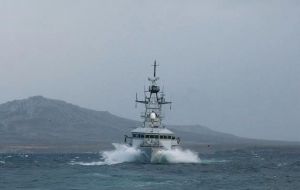MercoPress. South Atlantic News Agency
Britain sends special highly skilled unit SPAG, to help with the submarine search
 HMS Protector has a mull-beam echo sounder on her hull that can scan the depths for sign of life.
HMS Protector has a mull-beam echo sounder on her hull that can scan the depths for sign of life.  Falklands patrol HMS Clyde is returning from South Georgia, although she will take a few days sailing to reach the area
Falklands patrol HMS Clyde is returning from South Georgia, although she will take a few days sailing to reach the area  A special unit called SPAG has been sent to the South Atlantic from UK. The Submarine Parachute Assistance Group is a little known but highly skilled unit.
A special unit called SPAG has been sent to the South Atlantic from UK. The Submarine Parachute Assistance Group is a little known but highly skilled unit. Britain has increased efforts to help find the missing Argentine submarine ARA San Juan in the vast stormy South Atlantic. HMS Protector, the Royal Navy's Ice Patrol ship, is now in the search area where the submarine last made contact on Wednesday.
HMS Protector has a mull-beam echo sounder on her hull that can scan the depths for sign of life. Likewise Falklands patrol HMS Clyde is returning from South Georgia - she will take a few days sailing to reach the area, and a C130 Hercules is on standby in the Falklands MPA complex.
Besides from Britain a special unit called SPAG has been sent to the South Atlantic. The Submarine Parachute Assistance Group is a little known but highly skilled unit. The group - fewer than 10 personnel - can deploy at six hours' notice.
If required they can parachute into the seas to rescue stranded submariners. The SPAG is made up of underwater medics, engineers and specialist escape technicians. Equipment pods dropped with them carry inflatable boats, food, water and other supplies. They can function as a first-response for more than 24 hours whilst other ships make their way to the scene.
The US Navy is now operating from the Patagonia city of Comodoro Rivadavia, where California-based Undersea Rescue Command has been deployed with all its rescue equipment, including two underwater craft designed to rescue trapped submarine sailors. A NASA P-3 research aircraft was among the first to join the search.
See the HMS Protector in the area




Top Comments
Disclaimer & comment rules-

-

-

Read all commentsThis international effort is very welcome. I pray these mariners are rescued soon.
Nov 21st, 2017 - 09:12 am +4It's been a long time now since Argentina said that they have lost contact with a submarine, they should have come clean earlier, I think there is little hope for them now. What is it now 7 days?
Nov 21st, 2017 - 04:03 pm +1Not much hope for them now
Nov 23rd, 2017 - 09:42 am 0Commenting for this story is now closed.
If you have a Facebook account, become a fan and comment on our Facebook Page!